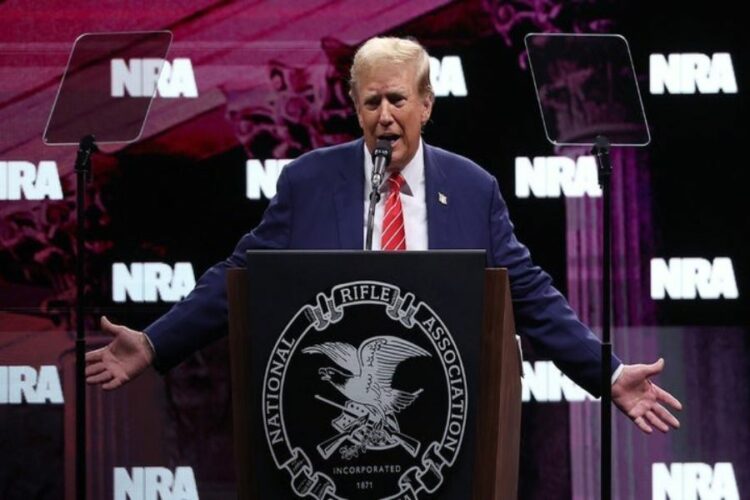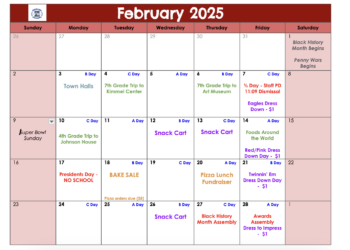At the annual National Rifle Association (NRA) convention held in Dallas, Texas, former President Donald Trump seized the stage with a vigor that underscored his strategic intentions. His address wasn’t merely a routine engagement but a carefully orchestrated effort to rekindle enthusiasm among his core supporters and strengthen his political foothold ahead of the 2024 presidential race.
Trump commenced his speech with a nod to the NRA, heralding their endorsement as a testament to shared values and mutual objectives. The NRA’s support is pivotal, not just as an endorsement of his candidacy, but as an emblem of his unwavering commitment to the Second Amendment—a cornerstone of his platform that resonates deeply with his audience.
As he stood before the assembly of dedicated supporters, Trump acknowledged them as “great patriots,” a recognition that reinforced their shared identity and commitment to conservative principles. However, his speech swiftly transitioned from commendation to a pointed critique regarding the electoral participation of gun owners. Trump highlighted this issue as a critical anomaly, given the community’s solid convictions and history of advocacy.
“We’ve got to get gun owners to vote because, you know what? Perhaps it’s a form of rebellion because you’re a rebellious people, right?” Trump posed to the audience. This rhetorical question was more than a mere query; it was a strategic invocation of the gun owners’ rebellious spirit, a call to harness that energy not just in defense of gun rights but at the ballot box.
Trump’s emphasis on the low voter turnout among gun owners served multiple purposes. First, it acted as a wake-up call to a community that prides itself on activism yet may have overlooked the power of their votes. Second, it was a clever maneuver to align voting with the notion of rebellion—a potent and resonant idea within the NRA community. By framing voting as an act of rebellion, Trump tapped into a powerful narrative of defiance against perceived governmental overreach and liberal policies.
This part of Trump’s speech was crucial because it underscored a significant gap in political engagement that, if bridged, could dramatically shift electoral dynamics in favor of conservative candidates. The call to action was clear and pointed: mobilize and transform the political landscape through increased voter participation. Trump’s direct address sought not only to motivate but also to catalyze a movement among gun owners, urging them to see voting as both a right and a responsibility crucial to safeguarding their interests.
In essence, Trump’s address at the NRA convention was a masterful blend of celebration and mobilization. By connecting with his audience through shared values and guiding them towards greater electoral activism, he aimed to fortify his base, ensuring that their fervor translates into tangible political outcomes in the upcoming election. This strategic focus on voter mobilization among gun owners could be pivotal in the broader political strategy leading into 2024.
Confronting the Competition: RFK Jr.
In his address at the NRA convention, Trump’s focus sharply shifted as he aimed at Robert F. Kennedy Jr., who had emerged as an independent presidential candidate. Trump’s rhetoric intensified as he sought to discredit Kennedy’s campaign, branding him a representative of the “radical left.” With emphatic clarity, he urged the audience, “Don’t waste your vote on the radical left,” positioning the election as a stark choice between his conservative principles and Kennedy’s policies, which he portrayed as dangerously progressive.
Trump’s attack on Kennedy was both strategic and dismissive. He painted Kennedy not just as a political opponent but as an existential threat to the values held by his audience. This was a critique of Kennedy’s political stance and a broader appeal to his base’s fear of a leftward shift in American politics.
Moreover, Trump employed a vivid metaphor to diminish Kennedy’s stature, comparing him to an irritating fly. This comparison trivialized Kennedy’s political efforts and aligned them with nuisance rather than legitimacy. By doing so, Trump injected a touch of humor into his remarks and effectively conveyed his annoyance and contempt for Kennedy’s candidacy.
This rhetoric was designed to resonate with his audience, reinforcing their unity against what he framed as a common adversary. Such imagery highlighted Trump’s skill in using simple yet powerful analogies to communicate complex political sentiments, casting Kennedy as an unworthy contender for the nation’s highest office.
Challenging Biden’s Competence
In a particularly charged segment of his speech, Trump escalated his critique of President Joe Biden, targeting his mental acuity with unverified claims. Trump provocatively suggested that Biden seemed “high as a kite” during his recent State of the Union address. This bold assertion aimed to question Biden’s physical state during a significant national event and cast serious doubts about his overall fitness for the presidency.
Trump’s proposal for drug testing before debates added a tangible, albeit contentious, element to his accusations. By advocating for both candidates to undergo drug tests, Trump cleverly positioned himself as an advocate for transparency and accountability in the electoral process. This move was strategically crafted to bolster his image as the more reliable and capable candidate, contrasting himself with what he implied was a potentially impaired opponent.
The audience’s reaction, marked by cheers, indicated that this line of attack resonated with his supporters, reflecting a deep-seated skepticism about Biden’s capability to lead. Trump’s rhetoric here was not merely inflammatory—it was a calculated attempt to undermine the incumbent’s credibility and to reinforce his stature as the preferable alternative. This approach stirred controversy and reinforced his narrative of decisiveness and strength, critical components of his appeal to his base.
Strengthening the Coalition: Gun Owners for Trump
In addition to these personal attacks, Trump’s speech was strategically aligned with the creation of the “Gun Owners for Trump” coalition earlier that day. This initiative seeks to mobilize gun rights activists and individuals within the firearms industry, reinforcing Trump’s commitment to the Second Amendment and his strategy to galvanize a core component of his political base.
Trump’s address at the NRA convention was more than just a typical campaign speech; it was a masterclass in rallying a base around shared values and perceived threats from opposition figures. By casting Kennedy and Biden as antagonists to the conservative and Second Amendment-supporting crowd, Trump sharpened the us-versus-them narrative that has been central to his political identity.
The speech resonated with those in attendance and a broader audience that values gun rights as a symbol of freedom and resistance against perceived government overreach. As the election season progresses, Trump’s ability to maintain this narrative and energize his base through such appearances will be critical to his campaign strategy.
The forthcoming months will be telling. Will Trump’s provocative calls to action and sharp criticisms translate into a mobilized and enthusiastic voter turnout among gun owners? Or will his divisive rhetoric further polarize voters? The answers to these questions will shape the future of Trump’s campaign and the contours of American political discourse as the nation inches closer to another presidential election.







